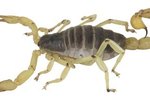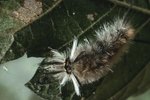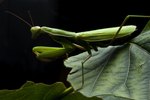
Large moths are not as commonly seen as their butterfly cousins, largely due in part to their nocturnal nature. Several species of large moth occur in North America and occasionally travel to the screens of doors and windows under a porch light. Three families of moths are known for large species, with the world's two largest moths being in Saturniidae or Noctuidae.
Saturniidae
The Saturniid moths include the royal moths and giant silk moths. The polyphemus moth (Antheraea polyphemus) has light brownish-gray wings with lighter-brown margins. The hind wings sport large black and yellow "eyes," while the forewings sport smaller eyes. Polyphemus moths have wingspans of 3 1/2 to 5 1/2 inches. The luna moth (Actias luna) is readily collected by amateur and professional collectors alike. The wings vary between yellowish- and bluish-green and have a swallowtail appearance with sweeping hindwing tails. The wingspan of this treasured moth is up to 4 1/2 inches. Other large Saturniid moths include the Io moth and imperial moth.
Sphinx Moths
The sphinx moth (Sphingidae) family includes moths commonly known as hawkmoths or hummingbird moths. Sphinx moths may be better known in their larval state, however. The caterpillars of these moths include the large, colorful tobacco and tomato hornworms. These moths closely resemble hummingbirds when they fly. They have large, bullet-shaped bodies and long, thin wings. Many are active during the day and fly from flower to flower, much like a twitting hummingbird does.
Owlet Moths
In North America, many of the owlet moths (Noctuidae sp.) are of economic importance. The caterpillars feed on a variety of crops. The common family name "owlet" comes from the reflective properties of their eyes. While they aren't particularly large in North America, one of the two largest species in the world belong to this family.
Largest Moths
The title for largest moth in the world is split between two different species: the atlas moth (Attacus atlas) and Thysania agrippina, which is commonly known as the great owlet or white witch moth. The Asian and Australian native, the atlas moth, has a wingspan reaching up to 1 foot and has the greatest wing surface area. The wingspan of the great owlet is typically reported to be just over 11 inches, although some reports state the wingspan extends more than 12 inches. The largest moths in North America are cecropia moths (Hyalophora cecropia), which belong to family Saturniidae. These moths have an impressive wingspans of between 5 and 7 inches.
References
- University of Kentucky: Saturniid Moths
- Iowa State University Extension: The Atlas Moth: A Gentle Giant
- University of Florida IFAS Extension: Largest Lepidopteran Wing Span
- Mississippi State University O. Orkin Insect Zoo: Class Hexapoda - Order: Lepidoptera
- Harvard University Farrell Lab: Family Sphingidae (Hawk Moths or Sphinx Moths)
- North Dakota State University: Family Noctuidae: Owlet Moths
Resources
Photo Credits
-
Brand X Pictures/Brand X Pictures/Getty Images
Writer Bio
With a professional background in gardening, landscapes, pests and natural ecosystems, Jasey Kelly has been sharing her knowledge through writing since 2009 and has served as an expert writer in these fields. Kelly's background also includes childcare, and animal rescue and care.




